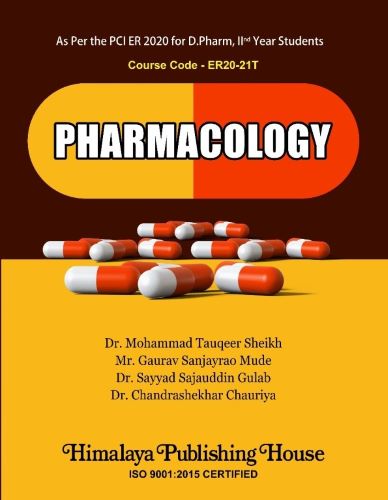Pharmacology is a fundamental course in the Diploma in Pharmacy (D. Pharm) curriculum, connecting basic sciences with clinical application. The textbook of Pharmacology for “Diploma in Pharmacy,” has been methodically designed to address the academic and practical requirements of D. Pharm students. It elucidates intricate pharmacological ideas and underscores their clinical significance, enabling students to comprehend the reason for drug treatment and its safe implementation in healthcare.
The information has been systematically arranged according to the curriculum established by the Pharmacy Council of India (PCI) and designed to facilitate learning via explicit explanations, graphics, mechanisms of drug action, dose regimens, therapeutic applications, and side effects. Flowcharts and pictures have been used where necessary to assist students in seeing and retaining the pharmacodynamic and pharmacokinetic routes.
This book integrates essential information with contemporary advancements, offering a robust foundation for students entering the healthcare and pharmaceutical sectors. This textbook is designed to be a dependable resource for students in hospital pharmacy, community pharmacy, or advanced courses throughout their professional career.
Contents –
1. Introduction and Scope of Pharmacology
1.1 What is Pharmacology?
1.1.1 Scope of Pharmacology
1.2 Routes of Drugs Administration
1.2.1 Classification of Routes
1.2.2 Advantages and Disadvantages
1.3 Drugs Absorption
1.3.1 Definition
1.3.2 Types of Absorption
1.3.3 Factors Affecting Absorption
1.4 Bioavailability
1.4.1 Definition
1.4.2 Factors Affecting Bioavailability
1.5 Drugs Distribution
1.5.1 Definition
1.5.2 Factors Affecting Drugs Distribution
1.6 Biotransformation (Metabolism) of Drugs
1.6.1 Definition
1.6.2 Types of Biotransformation Reactions
1.6.3 Factors Influencing Drugs Metabolism
1.7 Excretion of Drugs
1.7.1 Definition
1.7.2 Routes of Excretion
1.7.3 Factors Affecting Drugs Excretion
1.8 General Mechanisms of Drugs Action
1.9 Factors Modifying Drugs Action
1.10 References
2. Drugs Acting on the Peripheral Nervous System
2.1 Steps Involved in Neurohumoral Transmission
2.1.1 Steps of Transmission
2.2 Cholinergic Drugs
2.2.1 Definition
2.2.2 Classification
2.2.3 Pharmacological Actions
2.2.4 Dose Example
2.2.5 Indications
2.2.6 Contraindications
2.3 Anticholinergic Drugs
2.3.1 Definition
2.3.2 Classification
2.3.3 Pharmacological Actions
2.3.4 Dose Example
2.3.5 Indications
2.3.6 Contraindications
2.4 Adrenergic Drugs
2.4.1 Definition
2.4.2 Classification
2.4.3 Pharmacological Actions
2.4.4 Dose Example
2.4.5 Indications
2.4.6 Contraindications
2.5 Anti-Adrenergic Drugs
2.5.1 Definition
2.5.2 Classification
2.5.3 Pharmacological Actions
2.5.4 Dose Example
2.5.5 Indications
2.5.6 Contraindications
2.6 Neuromuscular Blocking Agents
2.6.1 Definition
2.6.2 Classification
2.6.3 Pharmacological Actions
2.6.4 Dose Example
2.6.5 Indications
2.6.6 Contraindications
2.7 Drugs Used in Myasthenia Gravis
2.7.1 Definition
2.7.2 Treatment Drugs
2.7.3 Pharmacological Actions
2.7.4 Dose Example
2.7.5 Indications
2.7.6 Contraindications
2.8 Local Anaesthetic Agents
2.8.1 Definition
2.8.2 Classification
2.8.3 Mechanism of Action
2.8.4 Dose Example
2.8.5 Indications
2.8.6 Contraindications
2.9 Non-Steroidal Anti-Inflammatory Drugs (NSAIDs)
2.9.1 Definition
2.9.2 Classification
2.9.3 Pharmacological Actions
2.9.4 Dose Example
2.9.5 Indications
2.9.6 Contraindications
2.10 References
3. Drugs Acting on the Eye, Miotics, Mydriatics and
Antiglaucoma Agents
3.1 Introduction
3.2 Anatomy and Physiology of the Eye
3.3 Overview of Ocular Pharmacology
3.4 Miotics
3.5 Mydriatics
3.6 Drugs Used in Glaucoma
3.7 References
4. Drugs Acting on the Central Nervous System (CNS)
4.1 Introduction to CNS Pharmacology
4.2 Classification of CNS Drugs
4.3 General Anaesthetics
4.4 Hypnotics and Sedatives
4.5 Anticonvulsant Drugs
4.6 Anti-anxiety Drugs
4.7 Antidepressant Drugs
4.8 Antipsychotic Drugs
4.9 Nootropic Agents
4.10 Centrally Acting Muscle Relaxants
4.11 Opioid Analgesics
4.12 References
5. Drugs Acting on the Cardiovascular System
5.1 Introduction
5.2 Anti-Hypertensive Drugs
5.3 Anti-Anginal Drugs
5.4 Anti-Arrhythmic Drugs
5.5 Drugs Used in Atherosclerosis
5.6 Drugs Used in Congestive Heart Failure (CHF)
5.7 References
6. Drugs Acting on Blood and Blood Forming Organs
6.1 Introduction
6.2 Hematinic Agents
6.2.1 Definition
6.2.2 Classification
6.2.3 Pharmacological Actions
6.2.4 Doses
6.2.5 Indications
6.2.6 Contraindications
6.3 Anticoagulants
6.3.1 Definitions
6.3.2 Classification
6.3.3 Pharmacological Actions
6.3.4 Doses
6.3.5 Indications
6.3.6 Contraindications
6.4 Antiplatelet Agents
6.4.1 Definition
6.4.2 Classification
6.4.3 Pharmacological Actions
6.4.4 Doses
6.4.5 Indications
6.4.6 Contraindications
6.5 Thrombolytic Drugs (Fibrinolytics)
6.5.1 Definition
6.5.2 Classification
6.5.3 Pharmacological Actions
6.5.4 Doses
6.5.5 Indications
6.5.6 Contraindications
6.6 References
7. Drugs Acting on the Respiratory System
7.1 Introduction
7.2 Bronchodilators
7.2.1 Definition
7.2.2 Classification
7.2.3 Pharmacological Actions
7.2.4 Dose
7.2.5 Indications
7.2.6 Contraindications
7.3 Expectorants
7.3.1 Definition
7.3.2 Classification
7.3.3 Pharmacological Actions
7.3.4 Dose
7.3.5 Indications
7.3.6 Contraindications
7.4 Anti-Tussive Agents
7.4.1 Definition
7.4.2 Classification
7.4.3 Pharmacological Actions
7.4.4 Dose
7.4.5 Indications
7.4.6 Contraindications
7.5 Mucolytic Agents
7.5.1 Definition
7.5.2 Classification
7.5.3 Pharmacological Actions
7.5.4 Dose
7.5.5 Indications
7.5.6 Contraindications
7.6 References
8. Drugs Acting on the Gastrointestinal Tract
8.1 Introduction
8.2 Anti-Ulcer Drugs
8.2.1 Definition
8.2.2 Classification
8.2.3 Pharmacological Actions
8.2.4 Dose
8.2.5 Indications
8.2.6 Contraindications
8.3 Anti-Emetics
8.3.1 Definition
8.3.2 Classification
8.3.3 Pharmacological Actions
8.3.4 Dose
8.3.5 Indications
8.3.6 Contraindications
8.4 Laxatives and Purgatives
8.4.1 Definition
8.4.2 Classification
8.4.3 Pharmacological Actions
8.4.4 Dose
8.4.5 Indications
8.4.6 Contraindications
8.5 Anti-Diarrheal Drugs
8.5.1 Definition
8.5.2 Classification
8.5.3 Pharmacological Actions
8.5.4 Dose
8.5.5 Indications
8.5.6 Contraindications
8.6 References
9. Drugs Acting on the Kidney
9.1 Introduction
9.2 Diuretics
9.2.1 Definition
9.2.2 Classification
9.2.3 Pharmacological Actions
9.2.4 Dose
9.2.5 Indications
9.2.6 Contraindications
9.3 Anti-Diuretics
9.3.1 Definition
9.3.2 Classification
9.3.3 Pharmacological Actions
9.3.4 Dose
9.3.5 Indications
9.3.6 Contraindications
9.4 References
10. Hormones and Hormone Antagonists
10.1 Introduction
10.2 Hormone: An Overview
10.2.1 Types of Hormones Based on Structure
10.2.2 Major Endocrine Glands and Their Hormones
10.2.3 Mechanism of Hormonal Action
10.2.4 Hormone Antagonists
10.2.5 Classification of Hormone Antagonists
10.2.6 Clinical Applications of Hormone Antagonists
10.2.7 Side Effects and Precautions
10.3 Thyroid Hormones: Overview
10.3.1 Physiological Role of Thyroid Hormones
10.3.2 Pathological Roles of Thyroid Hormones
10.3.3 Clinical Uses of Thyroid Hormones
10.4 Anti-thyroid drugs
10.4.1 Physiological and Pathological Role of the Thyroid Gland
10.4.2 Pharmacology of Anti-Thyroid Drugs
10.4.3 Clinical Uses of Anti-Thyroid Drugs
10.4.4 Adverse Effects
10.4.5 Monitoring and Duration of Therapy
10.5 Parathormone (PTH)
10.6 Calcitonin
10.7 Vitamin D
10.8 Insulin
10.9 Oral Hypoglycemic Agents (OAHs)
10.9.1 Physiological and Pathological Role
10.9.2 Pharmacology of Oral Hypoglycemic Agents
10.9.3 Clinical Uses of Oral Hypoglycemic Agents
10.9.4 Recent Advances and Guidelines
10.10 Estrogens
10.11 Progesterone
10.12 Oxytocin
10.13 Corticosteroids
10.14 References
11. Autocoids
11.1 Introduction
11.2 Physiological Role of Autocoids
11.2.1 Histamine
11.2.2 Serotonin (5-HT)
11.2.3 Prostaglandins
11.3 Antihistamines
11.3.1 Classifications
11.3.2 Clinical Uses
11.3.3 Adverse Effects
11.4 Serotonin (5-HT) Antagonists
11.4.1 Classification and Examples
11.4.2 Clinical Uses
11.4.3 Adverse Effects
11.5 References
12. Chemotherapeutic Agents
12.1 Introduction
12.2 Basic Principles of Chemotherapy
12.2.1 Selective Toxicity
12.2.2 Mechanisms of Action
12.2.3 Chemotherapy of Neoplastic Diseases
12.3 Classification of Chemotherapeutic Agents
12.4 Penicillins
12.4.1 Definition
12.4.2 Classification of Penicillins
12.4.3 Mechanism of Action
12.4.4 Dose (Selected Penicillins)
12.4.5 Indications
12.4.6 Contraindications
12.4.7 Adverse Effects
12.5 Cephalosporins
12.5.1 Definition
12.5.2 Classification of Cephalosporins
12.5.3 Mechanism of Action
12.5.4 Dose (Selected Cephalosporins)
12.5.5 Indications
12.5.6 Contraindications
12.5.7 Adverse Effects
12.6 Aminoglycosides
12.6.1 Definition
12.6.2 Classification of Aminoglycosides
12.6.3 Mechanism of Action
12.6.4 Dose (Selected Drugs)
12.6.5 Indications
12.6.6 Contraindications
12.6.7 Adverse Effects
12.7 Fluroquinolones
12.7.1 Definition
12.7.2 Classification of Fluroquinolones
12.7.3 Mechanism of Action
12.7.4 Dose (Selected Drugs)
12.7.5 Indications
12.7.6 Contraindications
12.7.7 Adverse Effects
12.8 Drugs Class: Macrolides
12.8.1 Definition
12.8.2 Classification of Macrolides
12.8.3 Mechanism of Action
12.8.4 Dose (Selected Drugs)
12.8.5 Indications
12.8.6 Contraindications
12.8.7 Adverse Effects
12.9 Drugs Class: Tetracyclines
12.9.1 Definition
12.9.2 Classification of Tetracyclines
12.9.3 Mechanism of Action
12.9.4 Dose (Selected Drugs)
12.9.5 Indications
12.9.6 Contraindications
12.9.7 Adverse Effects
12.10 Drugs Class: Sulphonamides
12.10.1 Definition
12.10.2 Classification of Sulphonamides
12.10.3 Mechanism of Action
12.10.4 Dose (Selected Drugs)
12.10.5 Indications
12.10.6 Contraindications
12.10.7 Adverse Effects
12.11 Drugs Class: Anti Tubercular Drugs
12.11.1 Definition
12.11.2 Classification of Anti Tubercular Drugs
12.11.3 Mechanism of Action
12.11.4 Dose (First Line Drugs)
12.11.5 Indications
12.11.6 Contraindications
12.11.7 Adverse Effects
12.12 Anti-Fungal Drugs
12.12.1 Definition
12.12.2 Classification of Anti-Fungal Drugs
12.12.3 Mechanism of Action
12.12.4 Dose and Administration
12.12.5 Indications
12.12.6 Contraindications
12.12.7 Adverse Effects
12.13 Anti-Viral Drugs
12.13.1 Definition
12.13.2 Classification of Anti-Viral Drugs
12.13.3 Mechanism of Action
12.13.4 Dose and Administration
12.13.5 Indications
12.13.6 Contraindications
12.13.7 Adverse Effects
12.13.8 Drugs Resistance
12.14 Anti-Amoebic Agents
12.14.1 Definition
12.14.2 Classification of Anti-Amoebic Agents
12.14.3 Mechanism of Action
12.14.4 Dose and Administration
12.14.5 Indications
12.14.6 Contraindications
12.14.7 Adverse Effects
12.14.8 Combination Therapy
12.14.9 Clinical Guidelines and Recommendations
12.15 Anthelmintic Agents
12.15.1 Definition
12.15.2 Classification of Anthelmintic Agents
12.15.3 Mechanism of Action
12.15.4 Dose and Administration
12.15.5 Indications
12.15.6 Contraindications
12.15.7 Adverse Effects
12.15.8 Special Consideration
12.15.9 Combination Therapy
12.16 Anti-Malarial Agents
12.16.1 Definition
12.16.2 Classification of Anti-Malarial Agents
12.16.3 Mechanism of Action
12.16.4 Pharmacokinetics and Dosage
12.16.5 Indications
12.16.6 Contraindications
12.16.7 Adverse Effects
12.16.8 Treatment Guidelines: WHO Recommendations
12.16.9 Resistance Patterns
12.17 Anti-Neoplastic Agents
12.17.1 Definition
12.17.2 Classification
12.17.3 Mechanism of Action
12.17.4 Commonly Used Anti-Neoplastic Agents: Dose, Indications & Contraindications
12.17.5 Adverse Effects
12.18 References
13. Biologicals: Definition, Types and Indications of Biological Agents with Examples
13.1 Introduction
13.2 Definition of Biologicals
13.3 Classification of Biological Agents
13.4 Tree Diagram: Classification of Biologicals
13.5 Mechanisms of Action
13.6 Indications of Biological Agents
13.7 Advantages of Biologicals
13.8 Limitations
13.9 Flowchart: Development of a Biologic Drug
13.10 Adverse Effects
13.11 References






